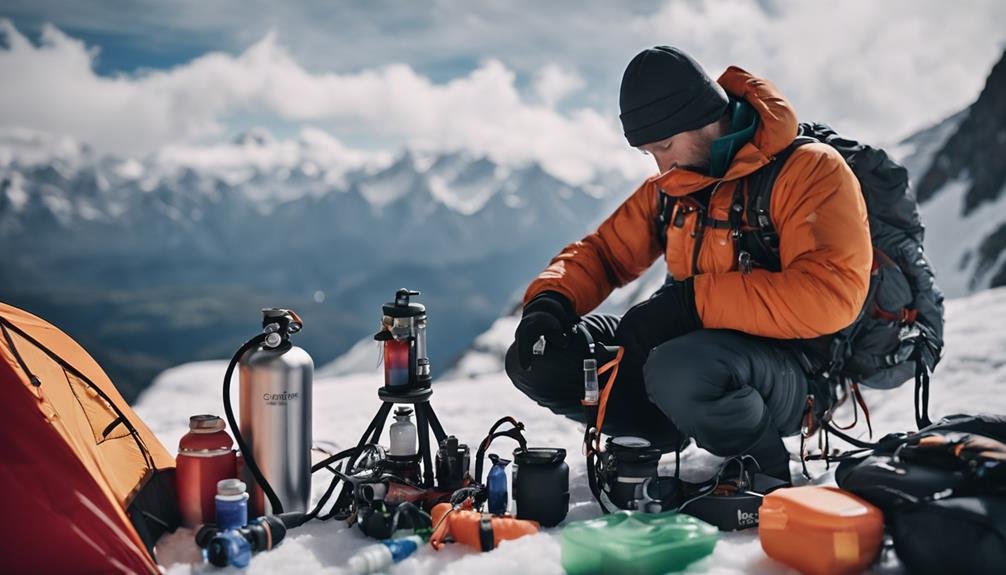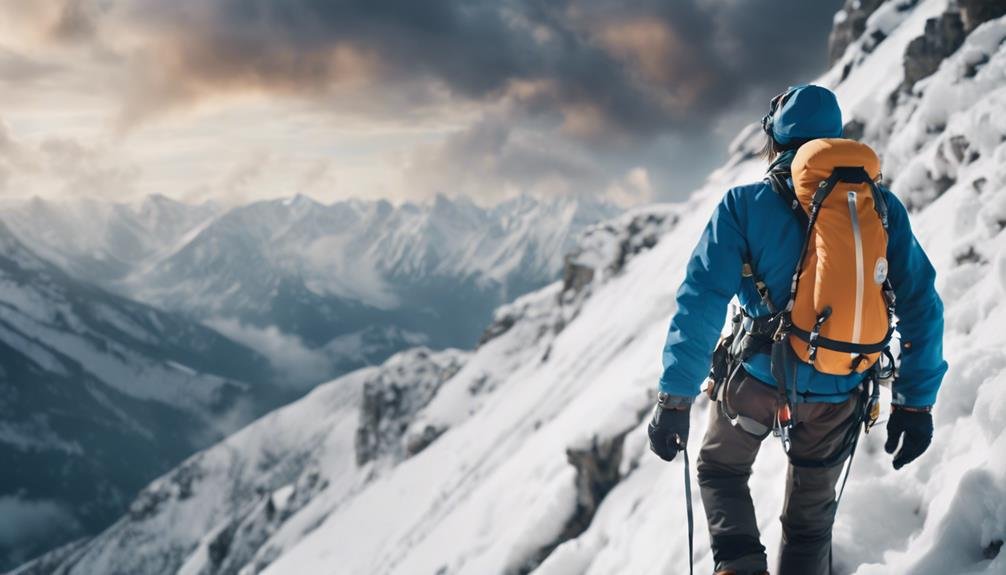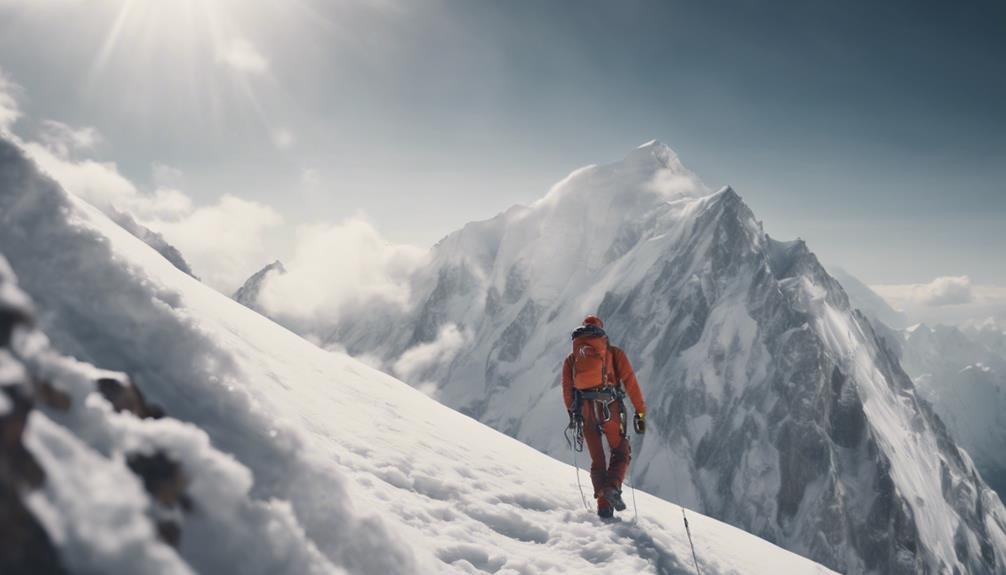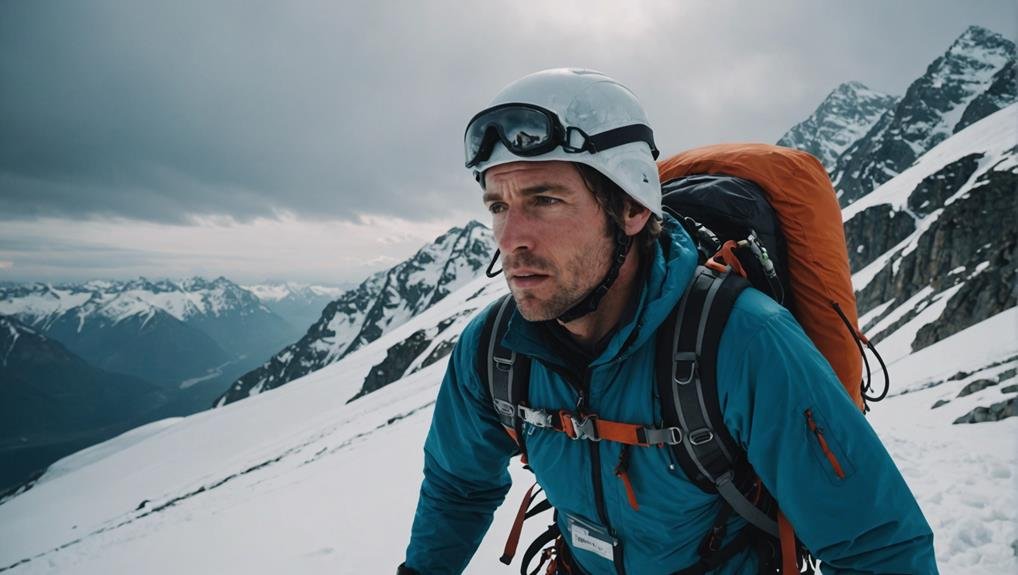As you get ready to tackle the challenge of climbing a big mountain, it’s crucial to grasp the risks associated with altitude sickness. The thin air up there isn’t just hard to breathe; it can trigger a range of symptoms that might jeopardize your climb.
You’re likely aware of the usual headaches and dizziness, but did you know that ignoring these signs can lead to more severe conditions, such as HAPE or HACE, which can be fatal? It’s not just about making it to the top; it’s about making it back down safely. So, how can you prepare to guarantee your body copes with the high altitude?
Key Takeaways
- Gradually ascend, limiting elevation gain to 300 meters per day above 3000 meters to prevent altitude sickness.
- Incorporate rest days every 800 meters ascent above 8000 feet to aid acclimatization.
- Carry out and know when to use supplemental oxygen to manage low oxygen levels at high altitudes.
- Recognize early symptoms of altitude sickness like headaches and nausea for timely intervention.
- Consider preventive medications like acetazolamide to reduce the risk of altitude sickness.
Understanding Altitude Sickness
Altitude sickness occurs when your body reacts negatively to the decreased air pressure and lower oxygen levels at high elevations. As you ascend to higher altitudes, the atmosphere contains less oxygen per breath. This reduction challenges your body’s ability to supply sufficient oxygen to tissues, particularly your brain, which is highly sensitive to oxygen deprivation.
Understanding the physiological impacts of high altitudes is important to prevent altitude sickness. When you’re at elevated heights, your body compensates for lower oxygen availability by increasing breathing and heart rates. However, these adjustments aren’t immediate.
Acclimatization, which involves gradual ascent and spending several days at moderate altitudes before climbing higher, allows your body to adapt more effectively to oxygen scarcity.
Preventative measures also include adequately hydrating and maintaining energy levels with carbohydrates. It is crucial to avoid alcohol and sedatives, which can decrease your respiratory drive during sleep. These substances exacerbate the oxygen deprivation your body is already struggling with at high altitudes.
Recognizing Symptoms
As you climb to higher elevations, you’ll need to recognize several key symptoms of altitude sickness. Early on, you might experience mild symptoms such as headache, nausea, and fatigue. It’s important to feel lethargic and suffer from a noticeable drop in performance or struggle with insomnia.
These signs should be monitored closely, as they can escalate. As your ascent continues, pay attention to any lack of coordination, a significant indicator of altitude sickness. This can signal the onset of more severe conditions like high-altitude cerebral edema (HACE) or high-altitude pulmonary edema (HAPE). HACE is characterized by confusion and can rapidly worsen, requiring immediate action.
Likewise, symptoms of HAPE might include breathlessness at rest, cyanosis (a bluish discoloration of the skin), and frothy sputum. If these severe symptoms appear, initiating an immediate descent is important.
Delaying can lead to critical outcomes. Recognizing these symptoms early and responding promptly ensures better safety and health as you navigate higher altitudes. Always prioritize your well-being by being attentive to how your body reacts to the elevation changes.
Prevention Strategies

To effectively prevent altitude sickness, it’s essential to plan a gradual ascent, ideally not exceeding an increase of 300 meters per day once above 3000 meters. This strategy minimizes the risk by allowing your body to acclimatize to the decreasing oxygen levels at higher elevations.
It is important to incorporate rest days every time you ascend 800 meters above 8000 feet. These pauses in your climb aren’t merely breaks but necessary periods for your body to adjust and respond to the changes in altitude. Early detection of symptoms plays a noteworthy role in prevention.
Be vigilant and aware of any discomfort that could indicate the onset of altitude sickness. Carrying supplemental oxygen can be a lifesaver in environments with thin air. It ensures that you maintain adequate oxygen saturation levels, essential in preventing the condition.
Additionally, preventive medications like acetazolamide, which can reduce the likelihood of developing altitude sickness, should be considered. Additionally, lifestyle choices can impact your susceptibility. Avoid alcohol, as it can dehydrate you and exacerbate symptoms.
Ensure you’re well-hydrated and consume a high-carbohydrate diet to maintain energy levels, which is crucial at high altitudes. These measures collectively form a robust prevention strategy against altitude sickness.
Immediate Treatment Options
While preventive measures are pivotal in safeguarding against altitude sickness, knowing how to respond when symptoms arise immediately can greatly enhance recovery. If you’re experiencing symptoms, the most effective immediate treatment is descending to a lower altitude.
This helps alleviate symptoms by improving your oxygen levels. Acting promptly is imperative, as delaying can lead to severe complications. Avoiding alcohol and cigarettes during this critical period is also important. These substances can exacerbate symptoms and hinder your recovery process.
Instead, focus on maintaining hydration and encouraging deep breathing to maximize oxygen intake. If symptoms persist, administering over-the-counter pain relievers such as aspirin or paracetamol can relieve headaches and body aches. For more severe symptoms, oxygen therapy might be necessary.
This involves supplying supplemental oxygen to boost saturation levels and facilitate recovery. In extreme scenarios, treatments might extend to diuretics or even hyperbaric oxygen therapy. Here’s a breakdown of immediate treatment options:
| Treatment | Purpose | Details |
|---|---|---|
| Descend | Alleviate symptoms, improve oxygen | The pivotal first step is to act promptly |
| Avoid alcohol/cigarettes | Prevent worsening of symptoms | Supports overall recovery |
| Pain relievers | Manage headache, body aches | Aspirin or paracetamol recommended |
| Deep breathing | Increase oxygen intake | Improves oxygen saturation levels |
| Oxygen therapy | Supplemental oxygen for severe cases | May include diuretics or hyperbaric |
Each step is integral to managing altitude sickness effectively and ensuring a safer, quicker recovery.
High Altitude Health Risks

Exploring high altitudes exposes climbers to significant health risks, including altitude sickness that can escalate from mild discomfort to life-threatening conditions. Altitude sickness, often exceeding 2,500 meters, is primarily due to dwindling air pressure and lower oxygen levels.
You’ll likely encounter Acute Mountain Sickness (AMS), the mildest form, characterized by symptoms such as headaches, nausea, and fatigue. However, without proper management, you could develop more severe conditions like High Altitude Pulmonary Edema (HAPE) or High Altitude Cerebral Edema (HACE), which demand immediate action to prevent fatal outcomes.
If you have pre-existing medical conditions, such as diabetes or heart disease, it’s important to consult a health professional before your climb. They can offer guidance tailored to your health needs and the risks associated with high altitudes. Additionally, increasing your fluid intake can help mitigate some symptoms of altitude sickness by maintaining adequate hydration.
In cases of severe altitude sickness, descending to a lower altitude is essential. This quick response is often the most effective way to reverse the dangerous effects of high-altitude pulmonary and cerebral conditions. Always prepare for sudden changes in your health status and plan your ascent to allow ample time for acclimatization.
When to Seek Medical Help
Recognizing when to seek medical help is key when symptoms of altitude sickness, such as headaches, nausea, and fatigue, become apparent during your climb. Don’t hesitate to contact a medical professional if these initial symptoms persist or worsen, as early diagnosis and treatment are vital for your recovery.
It’s imperative to monitor for more severe signs that necessitate immediate action. If you experience altered alertness, blood in your cough, or severe breathing issues, these are clear indicators of potentially life-threatening complications like cerebral or pulmonary edema.
In such cases, an emergency descent isn’t just advisable; it’s crucial to prevent the worsening of your condition. Delaying medical intervention can lead to dire consequences, including coma. The importance of descending immediately can’t be overstated, as lowering altitude often provides significant symptomatic relief and is a critical step before professional medical treatment can be administered effectively.
Always prioritize your health and safety by responding swiftly to the onset of symptoms and escalating your response as the severity increases. This approach ensures the best possible outcome in managing the risks associated with altitude sickness.
Safe Climbing Practices

Adhering to established safe climbing practices is critical to guaranteeing your safety when climbing at high altitudes. A gradual ascent is paramount. Once you’re above 3000 meters, you shouldn’t exceed an elevation gain of 300 meters per day. This approach aids in acclimatization, allowing your body to effectively adjust to decreasing oxygen levels and minimizing your risk of altitude sickness.
Incorporate rest days for every climb above 8000 feet. These aren’t merely pauses but essential for your body to adapt and recover, further enhancing acclimatization. Be vigilant about the early symptoms of altitude sickness; recognizing these signs can be lifesaving. Carrying supplemental oxygen and knowing when to use it can mitigate severe effects as you climb higher.
You should also consider preventive medications like acetazolamide, which can reduce symptoms and improve oxygenation. However, avoid alcohol as it can exacerbate altitude sickness. Finally, balance your climbing ambitions with those of your group. Avoid overexertion by listening to your body and adhering to these safe climbing practices, ensuring a safer, more enjoyable, high-altitude experience.
Conclusion
As you climb higher, remember altitude sickness is a critical risk. Recognize early symptoms like headaches and nausea, and don’t underestimate their severity. Gradually ascend, take rest days, and use supplemental oxygen if needed. If symptoms persist, immediate treatments, including descent and medication, are crucial.
Always be ready to seek professional medical help. Adhering to safe climbing practices and prioritizing acclimatization will enhance your mountain experience while safeguarding your health. Stay informed, stay safe.
Discover More Articles:
What to Do in West Yellowstone: Exploring Nature and Wildlife
Congaree National Park: Discover the Hidden Gems of Carolina
Gear Review the Tinkle Belle Stand to Go Easily and Discreetly

